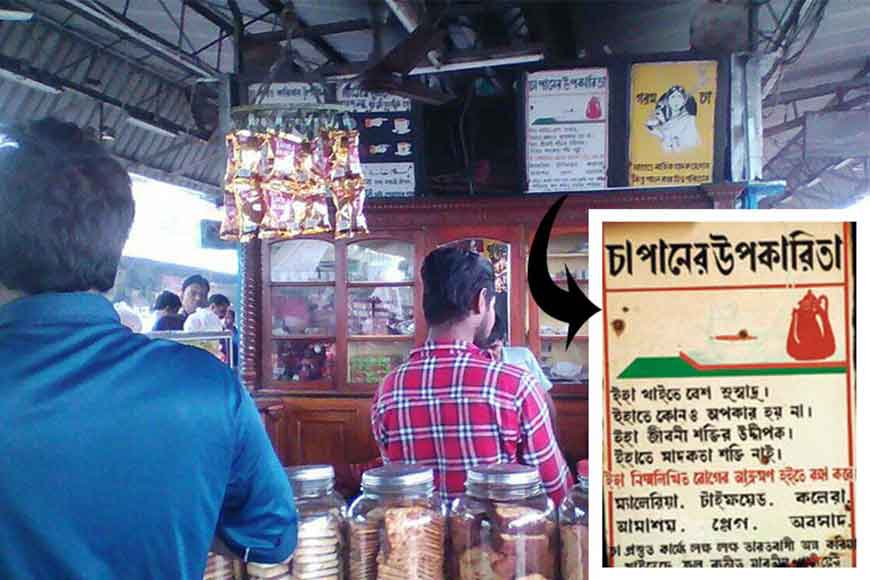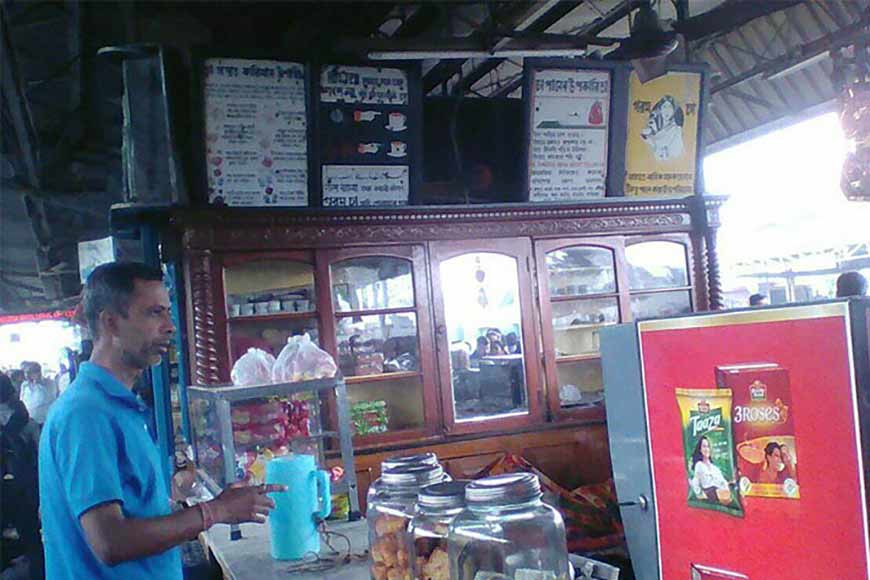Century-old Tea Advertisement at the historical H.C. Dey tea stall of Dumdum

Cha, is not just a word in Bengali. It’s an emotion, a feeling. You can’t really start your day without a cup of shokaler cha (morning tea). Every street in Kolkata has at least one Cha-walah, literally meaning a tea-seller. Be it as late as 2am or as early as 5am, you’ll always find a tea stall somewhere or the other operating with as much gusto as any other time of the day, with a crowd huddled up reaching out for their cups of the magic potion. You’re not a Cha-lover if you don’t lose count of the cups of tea you had all day.
Tea, in India and especially Bengal, has stood witness to a tumultuous history, with the British East India Company initiating organized commercial tea production for the first time in the country. What was once considered as a drink for the royalty gradually became a staple for the masses. There is a quaint little tea stall tucked in at the intersection of Platforms Numbers 2 and 3 at Dum Dum Junction. It is an ancient kiosk that has been operating since pre-Independence era. Catering contractor H.C. Dey under the British government used to run the shop. If you happen to be there, you will notice a tin display board in one corner of the shop with a number of tea-related advertisements prominently written in Bengali, all promoting the beneficial effects of tea. These advertisements are more than a century old, but they have been preserved with love and utmost care in the stall.
The advertisements are quite different from the ones we are accustomed to see these days. The commercials emphasize the goodness of tea as a beverage. It says tea is a tasty and healthy drink full of nutrition. It is a medicinal beverage with therapeutic properties and can cure ailments like malaria, typhoid, cholera, dysentery, plague and mental stress. It is not addictive. The copy ends with a note that many people are involved in this industry and tea is the cheapest drink available and the most affordable drink in the market other than water. But what was the actual intention of the advertisement?

To find the answer, we will have to retrace our journey to a time about 150 years ago. China had been the country of origin for all tea imports into Britain. However, as the demand for tea became greater, the British eyed India as having potential to overthrow the Chinese monopoly on the product. The British East India Company, a powerful and exploitative trading body that allowed England to take part in the East Indian spice trade, stepped forward. Work on Bengal-Assam railway was initiated in 1892. The main route went through Comilla, Badarpur, Akhaura via Lamding and the branch line went through Tinsukia till Guwahati. This route covered the tea estates of Assam. After the railway tracks were laid, labourers from Bihar, Bengal and Odisha migrated in large numbers to work in the tea estates.
The British planters were oppressive and intimidated the workers and created a sense of fear among them. The life of the coolies under the sadistic tea planters was harsh and dismal. They got a meagre amount as wage (50 paise per day), there was a perpetual shortage of food, epidemics and diseases thrived. This was complimented by the cruelties meted out to the labourers by their European masters in the form of flogging, making them do extra work, confining them for days without food, humiliating and threatening them with trained dogs that would find those who fled and much more. Their life grew miserable by each passing day.
With the rise of nationalism all over the country, there was a widespread protest against the cruelties perpetrated on the coolies, the high mortality rates and abysmal living arrangements, and slave-like working conditions on the tea gardens. Mahatma Gandhi launched the nation-wide non-cooperation movement and inspired by it, the workers joined in. They stopped working in the gardens, forcing the gardens to down shutters. The British retorted by stalling sale of railway tickets to the coolies. Amid this disturbance, the British police fired at coolies who were sleeping at Goalanda Steamer Ghat. A number of them died on the spot, leading to a wide-spread nation-wide protest.
 Calcutta’s Mayor Jatindra Mohan Sengupta and Nellie Sengupta sent protest letters against the brutalities of the British police force and the British felt the brunt of ire of the masses and the non-cooperation affected tea gardens, forcing closure of a large number of tea estates. The tea business was affected immensely. So, to revive the situation, the British now devised another strategy to popularize tea among the masses. In an effort to increase its consumer market, the company began the promotion of tea to the locals. Mandatory tea breaks were put in place in fields, factories, mines, and mills. With the opening of the Darjeeling Himalayan Railways in 1879, tea became more readily available to all parts of India.
Calcutta’s Mayor Jatindra Mohan Sengupta and Nellie Sengupta sent protest letters against the brutalities of the British police force and the British felt the brunt of ire of the masses and the non-cooperation affected tea gardens, forcing closure of a large number of tea estates. The tea business was affected immensely. So, to revive the situation, the British now devised another strategy to popularize tea among the masses. In an effort to increase its consumer market, the company began the promotion of tea to the locals. Mandatory tea breaks were put in place in fields, factories, mines, and mills. With the opening of the Darjeeling Himalayan Railways in 1879, tea became more readily available to all parts of India.
It was after the First World War that consumption of tea in India began to take shape. Railway stations from Bengal to Punjab started to set up shop and followed the British example by adding milk and sugar, though there were local twists too: sweet spices such as cardamom and ginger were mixed into strong black tea, along with creamy buffalo milk, before being boiled. Advertisements and propaganda followed promoting the consumption of tea to all classes of society. By the 1930s, the sale of Cha from street-side vendors boomed. The trick worked well in favour of the Brits and the billboard at the ancient tea shop at Dum Dum Junction still stands at the spot it was first placed as a reminder.
Image Courtesy :Santanu Debnath










